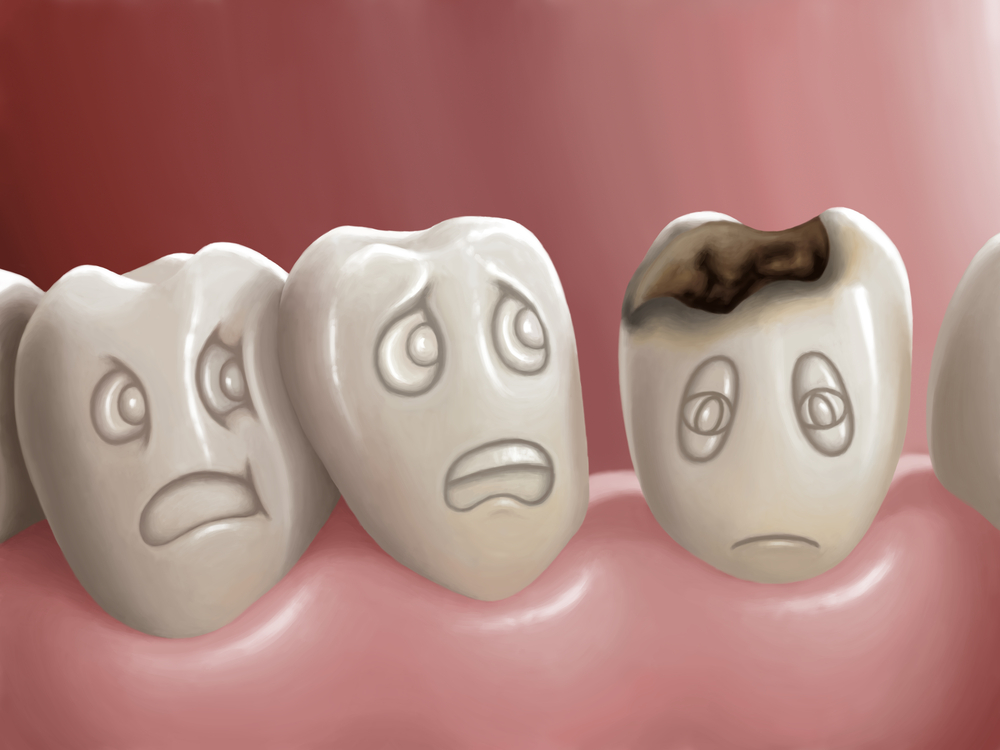 Did you know that 60 – 90% of children worldwide have dental cavities? For most people, that seems pretty obvious. But, what might surprise you is that nearly 100% of adults also have cavities! Cavities, along with gum infection, are the two most common forms of oral diseases. The good news is, cavities can easily be prevented.
Did you know that 60 – 90% of children worldwide have dental cavities? For most people, that seems pretty obvious. But, what might surprise you is that nearly 100% of adults also have cavities! Cavities, along with gum infection, are the two most common forms of oral diseases. The good news is, cavities can easily be prevented.
What is a Cavity?
Cavities are tiny pockets or openings found at the surface of a tooth, where presence of decay is typically found. It is the process in which the tooth’s enamel is slowly eroding and the structure of the tooth is eaten away. But what causes our tooth’s enamel to break down? The answer is…Acid. Acid comes from the foods and drinks that we consume. More specifically, the sugars contained in them act as the main catalyst in the formation of a cavity. Our mouths contain essential enzymes and bacteria that help us digest and break down the food that we eat. Unfortunately, when the bacteria breaks down sugar compounds from food particles that are left behind, it also produces an unwanted byproduct. This byproduct is essentially Acid. As more and more acid is produced, it will begin to slowly eat away the enamel layer of the tooth, and if left untreated, major issues concerning the tooth’s structure will arise.
Certain foods are more prone to causing cavities. These foods are usually high in sugar content. Obvious examples are candy, sodas, and other sweets. But, there are also a number of foods that are high in sugar content that might surprise you. These are pastas, breads, cereals, and other starchy foods. They are also referred to as carbohydrates, or carbs. The sugars found in carbs come in the form of sucrose and are just as bad as traditional sugars found in your favorite snacks and desserts.
How Do I know If I Have a Cavity?
The most common symptom of a cavity is a toothache. But, in most cases, as soon as you experience a toothache, the cavity has probably grown too large. Many times, the cavity has eaten its way through the tooth and is now closing in on the tooth’s nerve. Frequent feelings of pain and sensitivity are easily triggered with just the slightest change in temperatures from normal activities such as eating or drinking, brushing, or even talking.
Although early signs of cavities can be challenging to detect on your own, it’s not completely impossible. A key indication for most cavities is discoloration or darker areas on the tooth’s surface. Pay attention to changes in your tooth’s color after brushing and flossing. Another characteristic of a cavity is the formation of pits or small holes on your tooth. You should carefully check for any holes that may appear on the tooth’s surface. You could also use your tongue to feel for any unusually rough surfaces. These are early signs of a cavity developing. Routine dental visits and checkups will definitely increase your odds of detecting early cavities. X-rays taken by your dentist can easily identify any early signs of cavities.
How Are Cavities Treated?
Treatment will vary with the severity of the cavity. Small cavities that are detected early will be much easier to treat and cost much less. A simple and routine exam by your dentist could easily identify early developments of a cavity, or tooth decay. For early detections, a simple filling could be all that is needed to take care of the cavity. With more severe cavities, where most of the tooth structure is compromised, treatment such as a crown may be necessary to protect and reinforce the remaining natural tooth once all decayed areas are removed. In cases where the cavity has grown too large, and nerve damage have occurred, root canal therapy may be the necessary treatment.
What Can I Do To Prevent Cavities
Although cavities is the most common oral disease, it’s also very treatable and preventable. Prevention is definitely the most cost effective and overall, the best form of treatment. Your chances of allowing cavities to develop can be significantly reduced with proper oral care and maintenance. That’s right, brushing and flossing alone could help fight against cavities. But, you have to do it properly and correctly. It starts with brushing twice a day and flossing daily. This will prevent any long term buildup of plaque and also rinses away those sticky sugars! Another helpful prevention tip is to maintain a healthier diet. That means less sweets and sugary foods. You don’t have to give them up completely, just have them in moderation.
If you have any other questions concerning cavities or you think you may be experiencing a cavity, give us a call or leave us a message.
Thank you for reading and remember to Like Us on Facebook and never miss another blog!
Written by Dr. Kim H. Nguyen

Owner of Mint Dental OC and is a leading dentist in Southern California.
